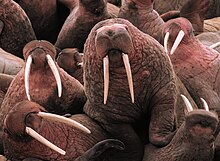హాయ్ మిత్రులారా నేను ఈ రోజు మీకు ఒక జంతువు గురించి చెప్పబోతున్నాను.

ఏనుగు దంతల్లాంటి కొమ్ములు ,ఎర్రటి కళ్ళతో భారీగా ఉంటాయివి . అటు నీటిలోను ఇటు నేలమీద ఎంచక్కా బతికేస్తాయి . పిల్లలకు పాలిచ్చి పెంచే ఈ క్షీరదాలు చూడడానికి వింతగా కనిపిస్తాయి. ఆర్కిటిక్ ధ్రువ ప్రాంతాలలో జీవించే వాల్ రస్ ల విశేషాలు చెప్పుకుందామా...
1) ఇవి 2000 వేల కిలోల బరువు పెరుగుతాయి.
2)వాల్ రస్ ల జీవితకాలం 20-30 సంవత్సరాలు.
3))వాల్ రస్ లు ఓడోబెనస్ కుటుంబానికి చెందినవి.
4)వీటిలో 3 ఉప జాతులు ఉన్నాయి.
5)ధ్రువ ప్రాంతాలలో జీవిస్తాయి ,అక్కడి చలిని తట్టుకునేందుకు వీలుగా వీటి చర్మం కింద బ్లాబ్బెర్ అనే కొవ్వు పొర ఉంటుంది. అది 5-6 అంగుళాల మందం ఉంటుంది.
6)ఇవి చిన్నపుడు గోధుమ రంగులో ఉంటాయి .
7)నీటిలో 10 నిమిషాల వరకు ఉండగలవు .
8)ప్రస్తుతం వాల్ రస్ ల సంఖ్య 2,50,000 మించి లేదని అంచనా.
9)మనుషుల వల్ల వీటికి ఆపద ఉంది .మనుషులు వీటి చర్మం దంతాల కోసం వీవీఎటిని వీటిని వేటాడతారు.
10)వీటి దంతాలు 39 అంగుళాల పొడవు ఉంటాయి.
మిత్రులారా వీటి గురించి తెలుసుకున్నారు కద. మరి మనం వీలైతే వీటిని రక్షించడానికి ప్రయత్నిద్దాము. ఇవి మన భావి తరాల వారు కూడా చూడాలి తెలుసుకోవాలి కాబ్బట్టి వీటిని కాపాడటం మన అందరి బాధ్యత.

ప్రశ్నలుంటే అడగండి ,తెలిసిన వారికీ తెలియ జేయండి మీ అభిప్రాయాలూ కామెంట్ చేయండి.




